Oil Pollution Effects on Phytoplankton Communities
Info: 13039 words (52 pages) Dissertation
Published: 10th Jun 2021
Abstract
Although several experimental studies demonstrated the impact of oil pollution on the marine environment with positive and negative effects, several aspects are unanswered as yet. We studied here the impact of petroleum hydrocarbon, PHC, on the marine environment, especially on phytoplankton ecology, based on field observations for two years at an oil exploratory site consisting of three consecutive seasons during the period from December 2011 to December 2013. PHC samples along with physio-chemical and biological parameters were analysed and processed for their inter-relationship of seasonal variation. The mean environmental parameters were observed below the permissible level including PHC. In addition box plots showing consistent variation in physico chemical parameters in all the seasons. A Pearson correlation analysis indicated that PHC has a stronger relationship with phytoplankton and chlorophyll-a than with nutrients. Furthermore, Kaiser-Meyer-Olkin (KMO) decisive factor deployed to find out the sampling adequacy, and our sample variable showed 0.72% of adequacy with strong positive loading of PHC (0.879) Chl-a (0.857) and Nitrite (0.826). Based on a standard calculation, the dominant phytoplankton species were examined and diatoms as a group were found dominant, followed by dinoflagellates, and than again by diatoms at species level, Skeletonema costatum, Melosira sulcata, and Ditylum brightwellii, during the drilling period. Overall the results suggested that PHC stimulates phytoplankton growth more than the nutrients.
Key Words: Marine pollution, crude oil, PHC, primary producers, nutrients, diatoms, dinoflagellates.
- Introduction
Marine ecosystem health is a hot topic in current marine environmental research and the health of the coastal marine environment is seriously affected by anthropogenic activities all over the world (Smith et al.,1999; Elmgren and Larsson, 2001; Rabalis and Nixon, 2002; Zheng et al., 2015; Song et al., 2017). There is an urgent demand to understand the activities between pollution and aquatic environmental health. Furthermore, phytoplankton commonly shows immediate responses to fast changing environmental conditions (Reynolds, 1984; Stolte et al., 1994; Luzia et al., 2015; Jaanus et al., 2017). Phytoplankton is considered as an excellent bio-indicator to assess seasonal, natural, and human-made changes in coastal ecosystems (Harris, 1986; Rimet and Bouchez, 2012). Human-made pollution affects most to the coastal environment and is increasing due to the development of industries and human activities in general through sewage, heavy metal, and oil spills. Recently, Oihane and co-workers (2017) showed that oil pollution significantly affected ribosomal biosynthesis and immune regulation in fish physiology significantly. Oil spills are shown to affect oyster populations and consequently the whole ecosystem (Vignier et al., 2017). However, crude oil spills are frequently occurring, and affecting the marine environment (NOAA). Petroleum hydrocarbon (PHC) is the primary constituent of crude oil (Shaik et al., 2015). Petroleum spills increased in coastal regions (Saramum and Wattayakorn, 2000; Tahir et al., 1997; Wattakayakorn, 2012) which can provide serious damage to biological communities (Hylland, 2006; Venkatachalapathy, 2012). Consequently, since the beginning of the 21st century several observational and experimental studies were conducted (Karina et al., 2001; González et al., 2009; Kendra et al., 2015) to better understand the impact of oil pollution on aquatic environment. Several studies asses oil pollution effects, such as by modeling the estimated ingested amount of marine organisms (Raymond et al., 2015) and the application of biomarkers to monitor aquatic organisms with respect to crude oil effects (Sanni et al., 2017; Smeltz et al., 2017; Steinar et al., 2017).
Metagenomic barcoding might provide the best tool to asses oil pollution effects on aquatic organisms (Olivier et al., 2017). Even though such advanced studies are conducted, there is a need of community monitoring at spatiotemporal scales in the area of an oil spill to see the effects on marine organisms in the environment (Pamela et al., 2017). Furthermore, some studies are showing a harmful effect of PHC on phytoplankton communities (Nayar et al., 2005; Parab et al., 2008). Other studies demonstrate that PHC enhance phytoplankton growth (Parsons et al., 1976; Miller, 1978; Carmen, 1995; Ozhan et al., 2014). Therefore, PHC pollution in coastal waters is an important research issue worldwide (Mackay and Hodgkinson, 1996). Phytoplankton represents not only a bio-indicator, it also plays a significant role in the global carbon system and may lead to changes of the carbon cycle. Several experimental studies were conducted to understand the impact of oil pollution on phytoplankton assemblages (Bruce et al., 1980; Kjetil et al., 1982; Tamarys et al., 2010; Huang et al., 2011).
The present investigation was carried out at a oil drilling exploratory site, which is located in the Krishna-Godavari basin of Kakinada coastal waters, at the southeast coast of India (Fig. 1). Even though the physio-chemical parameters of this region were well investigated before, there is no monitoring study available from an oil exploratory site. The possible impacts of fuel sources with their impact on phytoplankton towards other environmental parameters motivated us to carry out the present study. We particularly aimed at analyzing PHC along with other physio-chemical parameters in order to correlate them with the occurrence of phytoplankton at species level during different seasons of two consecutive years.
2. Material and Methods
2.1. Study area
The Krishna Godavari Basin (KG) is located in the Bay of Bengal along the Kakinada coast (16°41′–16°53′ N and 82°14′–82°21′ E) in Andhra Pradesh, India (Fig. 1). This basin has an area of more than 50.000 square kilometers. The Bay also receives a large volume of freshwater from several rivers opening into it, particularly during the monsoon (November – February) which drastically reduces the salinity in the Godavari basin down to 4PSU (Saisastry and Chandramohan, 1990). Moreover, India’s second largest mangrove swamp after Sundarbans is Coringa which is located in the southern part of Kakinada Bay and covers approximately 235 km2. This place is affected by heavy anthropogenic activities for the reason of widespread agricultural activities and landuse claims. Kakinada city is nicknamed as “Fertilizer city” due to many fertilizer industries located in nearby localities. The Nagarjuna Fertilizers and Chemicals are considered as one of the largest synthetic urea producers in India. It is strategically located at the Kakinada coast, which is spreading over 1130 acres. Several small channels connect between the Coringa mangrove and the Bay and transport a significant quantity of organic and inorganic materials into the Bay during the monsoon season.
2.2. Sampling and methods
For the field sampling an oil drilling site and its surroundings was selected. The sampling was carried out at 11 locations from 2011 (December ) – 2013 (December), covering two pre-drilling, drilling, and post-drilling seasons.. Each station was sampled at three sub-surface (1 m), mid-depth (25 m) and at near-bottom (65m) at all the stations. The water samples were collected using pre-cleaned 5L Niskin samplers (Hydrobios-Kiel) during the pre-drilling (December), drilling (April), and post drilling period (August) at the exploratory site. The vertical salinity and water temperature were measured by using portable Conductivity–Temperature–Depth profilers (CTD; SBE-19 plus, Sea-Bird Electronics, USA). Furthermore, for water quality analysis, 1 L of water samples were collected in pre-acid cleaned plastic Tarsion containers and kept closed until analysis, following standard methods (Grasshoff et al., 1999). Dissolved Oxygen (DO) and Biological Oxygen Demand (BOD) were analyzed by standard Winkler titration method (Winkler, 1888). The pH was measured on board using a calibrated pH meter. Chlorophyll-a (Chl-a) and pheophytin were measured by a calibrated Turner designed fluorometer (UNESCO, 1994), based on a standard protocol (Strickland and Parsons, 1984). Petroleumhydrocarbon (PHC) was analyzed and expressed in terms of µg/L, following the methodology of the IOC-UNESCO manual (UNESCO, 1984). For phytoplankton composition, 1L of water samples were collected from all stations at different depths (surface, mid-depth and near the bottom) and were fixed with Lugol’s iodine solution and by following a siphoning procedure, the samples were concentrated from 1L to 10 mL (Utermöhl, 1958). From this 1 mL sample was examined microscopically (Olympus XI 51) in a Sedgewick-Rafter counting cell at 60 X magnification by following the procedure of Tomas (1997). The phytoplankton groups were identified to the lowest possible taxon level.
2.3. Data analysis
Factor analysis (FA) is a mathematical approach which finds the relationship where variables are maximally correlated with one another. Furthermore, Wunderlin and co-workers (2001) stated that FA which consists of a Principal Component Analysis (PCA) is the most powerful and common technique which condenses large data sets without information loss. FA selects variables from a correlation matrix and resets them in a way to better explain the construction of the underlying system which produces the data. Besides, initially, the FA was done by principal component extraction method. After that, the factor loading matrix was rotated to a simple orthogonal arrangement according to the Varimax rotation technique. The Kaiser-Meyer-Olkin (KMO) decisive factor is followed to find out the sampling adequacy. The factors which best express the variance of the investigated data (eigenvalue > 1) can be taken for further interpretation analysis.
The range, mean and standard deviation of the physio-chemical and biological variables from the eleven stations were given as season-wise in Table 1. The bivariate Pearson Correlation was used in (SPSS.18) to understand the sample correlation coefficient r, which measures the strengths and relations among variables given in Table 2. Box-and-Whisker plots also called box plots (SPSS.18) were used to explain the physio-chemical and biological variables in a simple way of representing data on a plot where rectangles represent the mean and median values of the present data set (Fig. 3). Moreover, to determine the dominant species in the phytoplankton community, the following formula was used:
Yi=(Ni/N) × f i
In this, Yi is the dominance of species i, Ni is the number of individual species i at all stations (surface, mid-depth, and bottom). N is the number of individuals belonging to all species at all stations, and fi is the frequency of stations where i occurs. Plankton species with Y values greater than or equal to 0.02 were defined as dominant species according to (Yang et al., 1999; Lee et al., 2009; Lin et al., 2011) and respective results are shown in (Table 3)
3. Results
The Environmental variables recorded during the year 2012-2014: season wise, range, mean the permissible level given in (Table 1). The mean of all the parameters were observed below the permissible level. Further,water temperatures change consistently with season. The highest water temperatures (34.89 °C) were recorded during the drilling period as this was a post monsoon period with a mean value of (28.44 ± 3.31°C). There were no substantial changes in the salinity regime among seasons. Most interestingly, we recorded a slight elevation of salinity during monsoon (35.01 PSU) compared to summer (34.89 PSU), even though the study area received much freshwater influence each year. Furthermore, a low pH was recorded during the monsoon period, and no variation was observed in the mean pH among seasons. A high concentration of Dissolved Oxygen (DO) was recorded (4.97 ± 0.86) during the post monsoon. The highest level of BOD has been registered in the monsoon period (1.06 ± 1.02), while the lowest level (0.89 ± 0.51) was observed during postmonsoon. The means of nutrients (nitrite, ammonia and inorganic phosphate) were recorded with high values during the monsoon season while nitrate and silicate were recorded with high means during the post monsoon. The highest PHC means (4.56 ± 1.84) were registered during the postmonsoon period rather than during other seasons. Chlorophyll-a and pheophytin were recorded high in the postmonsoon and low during monsoon.
3.1. Box plot
(Fig 3) shows the box plots (box –and-whisker plots) for the selected physio chemical parameters. In the basic box, plot gives the visual impression of the location and shape of the underlying distributions. For example, box plots with higher whiskers at the top (such as nitrite, nitrate and inorganic phosphate) in the pre drilling season indicates the underlying distribution is skewed towards high concentration. Likewise, in these plots, large spread indicates the seasonal variations (see salinity and BOD in Pre –drilling season as well as nitrite, WT and PHC in drilling period in box plots). It is possible to perceive the differences in variation between the tides by inspecting these box plots. For instance, PHC, Chlorophyll and WT have great variation in every season. At the same time, the circles and asterisks so called (outliers and far outliers) which are distributed randomly to the pointing to the change in measurement variables in some seasons likely caused by anthropogenic activities or climatic factors which indicates that land run off from the shoreline also has an influence in the present investigation. In few times these outliers are considered as a data entry or measurement error, but if all the data entry process is checked thoroughly then these values cannot be avoided from the sample.
3.2. Phytoplankton species composition
Among the phytoplankton taxa we found diatoms to be the dominant phytoplankton group. Overall were 89 diatom species observed during the entire study period. Among them were Coscinodiscus radiatus, Pleurosigma elongatumand Podolampas palmipes, dominant during the pre-drilling (monsoon) period. During drilling (post-monsoon) Skeletonema costatum, Melosira sulcata, Rhizosolenia setigera, Bacteriastrum delicatulum, Ditylum brightwellii were among the dominant species. During post drilling (pre-monsoon) Biddulphia mobiliensis, Naviculadirecta, Cylindrotheca closterium, and Ceratium fusus were the dominant species. Interestingly, Pleurosigmaelongatum, Thalassionemanitzschioides,and Thalassiosira subtilis were the common dominant species during all seasons.
3.3. Correlation analysis
Correlation analysis was made for the present study to assess a possible association between physio-chemical and biological parameters. Pearson’s Correlation Coefficients were established by using a SPSS package. It demonstrated that the WT was positively correlated with most physio-chemical parameters, especially a strong positive correlation with Chl-a. Salinity has a negative correlation with IP. A negative correlation of DO was observed with BOD, ammonia, and IP. Furthermore, a significant negative correlation was found between chlorophyll-a and nutrient sources: nitrite, ammonia, and IP, and silicate concentration showed a positive correlation with Chl-a. Most interestingly, PHC showed a significant correlation with phytoplankton, chlorophyll, and pheophytin when compared to the most renowned limiting factors, nutrients, salinity, and water temperature for phytoplankton growth. Moreover, phytoplankton having a strong positive relation with Chl-a revealed that micro-phytoplankton had a main contribution. Phytoplankton also had a positive correlation with DO and a negative relation with IP. The measured data of physio-chemical and biological parameters from the current study were refitted into a box plot to know the seasonal variation pattern which were present in Fig. 3. In this, notably, the water temperature, dissolved oxygen (DO), PHC, and Chlorophyll-a were higher during the drilling period (post monsoon), whereas nitrite, nitrate, and IP were recorded high during the pre-drilling (monsoon). Besides, some parameters were showing prominent variations among seasons.
3.4. Factor analysis
Factor analysis was carried out on the present data set of physiochemical and biological parameters to understand the compositional patterns between the parameters and their influence (Table 4). Kaisere–Meyere–Olkin (KMO) values were established to measure the sampling adequacy which indicates the proportion of variance. In the present study, KMO is 0.723 showing that PCA can achieve a significant reduction of the dimensionality of the original dataset (Wu et al., 2010). The (Eigenvalue > 1) explained 62.60% of the total variance of the dataset; four factors were taken for the elucidation of results.
The first varifactor, with an eigen-value of 3.88, explained 27.7% of the total variance. It is clearly dominated by PHC, Chl-a, and phytoplankton, pheophytin, water temperature and DO which exhibited significant positive loadings, along with reasonable negative loadings of ammonia, IP, and nitrite. The Second (PC2) varifactor explained 15.9 % of the variance with 2.23 % of the eigenvalue. It indicated that nitrite had a strong positive loading with a moderate positive loading of nitrate, IP, and silicate. The third (PC3) revealed that BOD had a strong positive loading with a moderate loading of ammonia, and (PC4) described a strong positive loading of salinity with a moderate negative loading of phytoplankton.
4. Discussion
The Krishna-Godavari basin at the east coast of India shows temporal similarities in its physio-chemical profile but also illustrates considerable variation between seasons due to seasonal successions within the phytoplankton communities. There are no substantial changes in salinity between seasons. Interestingly, we recorded higher salinities during monsoon (35.01 PSU) than during summer (34.89 PSU), although the study area received much freshwater each year. Since we collected samples from 65m depth, where there was less possibility of freshwater influence to reduce the salinity than in surface waters, this may provide the reason for the high salinity in the study area during monsoon. Furthermore, during the whole investigation period, salinity was a dominated factor rather than temperature. A similar observation was reported by (Shetye et al., 1996) in the Bay of Bengal.
A low pH was recorded during the monsoon period which might be due to freshwater influence. Furthermore, not much variation was observed in the mean pH between seasons which was probably caused by the high buffering capacity of seawater (Riley and Chester, 1971; Moresco et al., 2012). However, photosynthetic and biological activities can also control the DO values in coastal waters (Shaik et al., 2015). Due to high phytoplankton production in the summer season with good light availability, the DO levels increase during post-monsoon because the phytoplankton produces oxygen as a by-product of the photosynthesis process. Furthermore, high BOD values were observed during monsoon. This might be due to freshwater discharges bringing organic debris to coastal waters which enhance microbial metabolic processes and subsequently affect the BOD values (Jha et al., 2015).
Higher PHC concentrations were observed during the post monsoon period than during other seasons due to oil drilling activity in that period. Shaik and co-workers (2015) recorded similar changes of PHC (1.49 to 17.60 µg/L) at the SW coast of the Bay of Bengal compared to our records at the Kakinada coast. Also, the author indicated that the PHC values recorded during our study revealed a fair range of values when compared to the ranges found in other Asian countries: China, Pakistan, Malaysia, and Thailand. As for India, Chouksey et al., 2004 reported PHC values within the range of 2.9-39.9 µg/L off the Mumbai Basin (west coast of India) from surface waters. These were fairly high values compared to the ranges that we observed. High chlorophyll-a and pheophytin were recorded during the post monsoon, contrary to low levels during monsoon. Likewise, (Redekar et al., 2000) recorded high chlorophyll-a during post monsoon and lower values during monsoon. The main reason for this was a wind-driven mixing of the water column which brought resuspended bottom-bound nutrients to the surface, triggering the growth of phytoplankton in the Bay of Bengal (Thangaradjou et al., 2013).
Among all identified species the significant abundance of Thalassiosira subtilis, and Pleurosigma elongatum, during all seasons, could be due to a unique feature (Cardoso et al.,2012). While, Stephanopyxis palmeriana, Guinardia striata, Guinardia indicusand Leptocylindrus minimus were found at low concentrations during all seasons due to the salinity drops in the study area ( Silva et al., 2017). This holds particularly for the monsoon (November – February) which drastically reduces the salinity in the Godavari basin down to 4 PSU (Saisastry and Chandramohan, 1990). Remarkably, in most studies of phytoplankton communities, diatoms were more dominant than other species, as they can tolerate the changing hydrographical conditions to grow better than other phytoplankton taxa (Mani, 1992; Kannan and Vasantha, 1992; Rajasekar et al., 2000). On the other hand, dinoflagellates mostly prefer oligotrophic waters and hence fail to survive in eutrophic waters by competing with diatoms (Menzel et. al., 1963; Cushing, 1989). This was found to be true in the present study, as the dinoflagellate assemblage was relatively less abundant throughout the observation period as compared to diatoms. Diatom species like Thalassionema nitzschioides, Thallassiothrix frauenfeldii, Gyrosigma balticum, Pleurosigma elongatum, Pleurosigma normanii, Pleurosigma sp., Navicula sp., Amphiphora gigantia, Nitzschia longissima, and Surirella sp. were commonly recorded and dominant species in the study area, followed by dinoflagellates like Prorocentrum micans, Prococentrum gracile, Dinophysis caudata, Ceratium fuscus, Gonyanux sp, Oxytoxum sp. The same diatoms and dinoflagellate species were identified from the East Coast of India by (Madhav and Kondalarao, 2004).
Moreover, the high positive correlation of WT with chl-a is due to a higher temperature, which increases the phytoplankton growth and shows a higher concentration of Chl-a in the open sea (Klapper, 2001). Meanwhile, the salinity has a negative relationship with inorganic phosphorous (IP) which indicates significant nutrient input from land and from freshwater origin into coastal waters (Todd et al., 2008; Vijayakumar et al., 2014; Shanthi et al., 2014). A similar observation was reported by Saisastry and Chandramohan (1990) in the Godavari Basin where the authors observed a 4 PSU reduction in salinity due to freshwater inflow during the monsoon period. Besides, a negative correlation of DO with BOD and nutrients was shown due to an input of inorganic compounds from land runoffs into the Bay of Bengal. A significant negative correlation was observed between chlorophyll-a and the following nutrients: nitrite, ammonia and IP. This may have favored the uptake and absorption of inorganic nutrients by phytoplankton, which then enhanced the elevated growth of phytoplankton and resulted in lower nutrient concentrations (Yang et al., 2008). Similarly, silicate has shown a positive association with Chl-a, and this was due to the dominant diatom species we could observe. Sarthou and co-authors (2005) suggested that diatom growth in the coastal environment is a straight response to silicate concentration, because diatom are using silicate to build their cell walls.
Most interestingly the PHC has shown a strong significant correlation with phytoplankton, chlorophyll, and pheophytin when compared to the main, common limiting factors for phytoplankton growth, namely nutrients, salinity, and water temperature. However, Ozhan and co-workers (2014) reported that oil sources stimulated phytoplankton, although at low salinities, the small phytoplankton cells are more tolerant to oil products at lower concentrations. For example, Gonzales and co-workers (2009) report that small diatoms (less than 20 µm) were not only more tolerant than bigger diatoms, but their growth was stimulated at a lower concentration of crude oil products. Moreover, Huang and co-workers (2011) reported that the relatively smaller diatoms Skeletonema coastatum and Melosira sp. became the dominant species and showed greater tolerance to crude oil products than larger phytoplankton. Several studies also suggested that lower levels of PHC concentrations stimulated the photosynthetic response of phytoplankton (Jiyalal Ram et al., 2013; Gordon and Parsons, 1984; Prouse, 1973). According to Huang et al. (2011) could high concentrations (≥2.28 mg L−1) of oil contamination restrain phytoplankton growth, decrease chlorophyll-a content and cell density, whereas, lower concentrations (≤1.21 mg L−1) did not restrain the growth but rather promoted phytoplankton growth. We observed maximum concentrations of PHC in our study was 9.63 µg L−1, which was lower than concentrations of ≤1.21 mg L−1. We conclude, therefore, that the growth of phytoplankton was stimulated by PHC since PHC was strongly correlated with phytoplankton growth, chlorophyll-a, and pheophytin. Since we found phytoplankton having a positive correlation with DO and a negative relation to IP, this means that DO is a promoting factor and phosphate is a limiting factor for phytoplankton.
The higher water temperatures during the drilling period is caused by intense solar radiation which increases the temperature in the Bay of Bengal (Das et al., 1997; Santhanam and Perumal, 2003). There is variation in the salinity and pH profile between seasons which could be due to freshwater influence. Nutrient conditions in the coastal waters are also affected by seasonal freshwater input and tidal conditions. In the present investigation nitrite, nitrate, and inorganic phosphate had high values in the pre-drilling period. This may be attributed to phytoplankton consumption which reduces the nitrite values (Gouda and Panigrahy, 1995; Das et.al., 1997). Notably, during the drilling period the phytoplankton, chl-a, DO, and PHC were recorded high, although nutrients were not showing higher values during that season. We suggest, therefore, that phytoplankton consumed PHC rather than inorganic nutrients and used it for their growth.
The first factor of variance in our PCA analysis showed that the common source of phytoplankton properties correlated negatively with nutrients and positively with PHC. The main source of phytoplankton uptake was PHC in the drilling season. The source of PHC in the study area was either oil splitting or a leakage of oil at the exploratory site during the drilling event. The second (PC2) varifactor, explaining 15.9% of variance, showed general and organic loads of nutrient sources NO3-N sources from the riverine freshwater direction. The most likely cause of this anthropogenic sources of water discharge into the coastal water, was mainly from the fertilizer industry (Nirmal Kumar et al., 2012) and from the Kakinada-Krishna Godavari estuary. This area is heavily affected by anthropogenic activities due to a great proximity to several fertilizer industries (Shaik et al., 2015). Hence, it is clear that the main nutrient source is land run off to the study area. High nutrient loadings were recorded in the Bay of Bengal from river influx due to monsoonal precipitation (Balliarsingh et al., 2015; Prasanna Kumar et al., 2010). In our study area Krishna-Godavari basin, Kakinada (Sooria et al., 2011) relatively high nutrient contents were recorded, mainly nitrate during monsoon due to excess run off by the Krishna Godavari river into the Bay of Bengal. The third varifactor (PC3) revealed that BOD has strong positive loadings with a moderate loading of ammonia, which indicates normal biological processes due to phytoplankton and microorganism assimilation (Sahu et al., 2013).
Conclusion
The present study shows that PHC has more interactions with phytoplankton than any other physicochemical parameter, in particular during the interannual seasons studied here. Furthermore, we observed Skeletonema costatumand Melosira sulcata as dominant species during the drilling events which show some evidence of the influence of PHC on phytoplankton species richness. Phytoplankton was influenced by PHC rather than by nutrients, particularly when their concentrations were
Referencesy
Baliarsingh, S.K., Lotliker, A.A., Sahu, K.C., Srinivasa Kumar, T., 2015. Spatio-temporal distribution of chlorophyll-a in relation to physicochemical parameters in coastal waters of the northwestern Bay of Bengal. Environ. Mon. Assess. 187, 481(1-14). DOI 10.1007/s10661-015-4660-x.
Bruce, M.M., Harold, H.H., 1980. The effects of petroleum hydrocarbons on the growth of phytoplankton recognized as food forms for the eastern oyster. Environ. Poll. Series Ecol. Biol. 22, 123-132. https://doi.org/10.1016/0143-1471(80)90188-9
Carman, K.R., Fleeger, J.W., Means, J.C., Pomarico, S.M., McMillinb, D.J., 1995. Experimental Investigation of the Effects of Polynuclear Aromatic Hydrocarbons on an Estuarine Sediment Food Web. Mar. Environ. Res., 40, 289-318. https://doi.org/10.1016/0141-1136(94)00146-G
Chouksey, M.K., Kadam, A.N., Zingde, M.D., 2004. Petroleum hydrocarbon residues in the marine environment of Bassein–Mumbai. Mar. Pollut. Bull. 49, 637–647. https://doi.org/10.1016/j.marpolbul.2004.04.007.
Cushing, D.H., 1989. A difference in structure between ecosystems in strongly stratified waters and in those that are only weekly stratified. J. Plankton Res. 11, 1-13. https://doi.org/10.1093/plankt/11.1.1
Das, J., Das, S.N., Sahoo, R.K., 1997. Semidiurnal variation of some physio-chemical parameters in the Mahanadi estuary, east coast of India. Ind J. Mar. Sci. 26, 323-326.
Da Silva, R., Mazumdar, A. , Mapder, T., Peketi, A., Joshi, R.K., Shaji ,A., Mahalakshmi,P.,. Sawant, B., Naik, B.G., Carvalho, M.A., & Molletti, S.K. (2017). Salinity stratification controlled productivity variation over 300 ky in the Bay of Bengal. Scientific Reports. 7: 14439. DOI:10.1038/s41598-017-14781-3.
Elmgren, R., Larsson, U., 2001. Eutrophication in the Baltic Sea area: integrated coastal management issues. In: Von Bodungen, B., Turner, R.K. (Eds.), Science and Integrated Coastal Management. Dahlem Univ. Press, pp. 15–35.
González .J, Figueiras, F.G., Aranguren-Gassis, M., Crespo, B.G., Fernández, E., Morán, X.A.G., Nieto-Cid, M., 2009. Effect of a simulated oil spill on natural assemblages of marine phytoplankton enclosed in microcosms. Est. Coast. Shelf Sci. 83, 265–276. doi:10.1016/j.ecss.2009.04.001.
Gordon, D.C., Prouse, N.J.Jr., 1973. The Effects of Three Oils on Marine Phytoplankton Photosynthesis. Mar. Biol. 22, 329-333.
Gouda, RS., Panigrahy, R.C., 1995. Ecology of phytoplankton in coastal waters off Gopalpur, east coast of India. Ind J. Mar. Sci, 2, 81-84.
Grasshoff, K., Kremling, K., Ehrhardt, M., 1999. Methods of Seawater Analysis, third ed. Verlag Chemie, Weinheim, Germany.
Harris, G.P., Hall, 1986. Phytoplankton Ecology: Structure Function and Fluctuation 384. Chapman & Hall, New York.
Huang, Y.J., Jiang, Z.B., Zeng, J.N., Chen, Q.Z., Zhao, Y.Q., Liao, Y.B., Shou, L., Xu, X.Q., 2011. The chronic effects of oil pollution on marine phytoplankton in a subtropical bay, China. Environ. Mon. Assess. 176, 517–530. https://doi.org/10.1007/s10661-010-
Hylland, K., 2006. Polycyclic aromatic hydrocarbon (PAH) ecotoxicology in marine ecosystems. J. Toxicol. Environ. Health 69 (1–2), 109-123.
Jaanus, A., Kuprijanov, I., Kaljurand, K., Lehtinen, S., Enke, A., 2017. Optimization of phytoplankton monitoring in the Baltic Sea. J. Mar. Syst. 171, 65–72. https://doi.org/10.1016/j.jmarsys.2016.10.009.
Jha, D.K., Vinithkumar, N.V., Sahu, B.K., Dheenan, P.S., Das, A.K., Begum, M., Devi, M.P., Kirubagaran, R., 2015. Multivariate and geo-spatial approach for seawater quality of Chidiyatappu Bay, south Andaman Islands, India. Mar. Pollut. Bull. 96, 463-70. 10.1016/j.marpolbul.2015.05.004
JiyalalRam, M.J., Ram, A., Rokade, M.A., Karangutkar, S.H., Yengal, B., Dalvi, S., Acharya, D., Sharma, S., Gajbhiye, S.N., 2013. Phytoplankton dynamic responses to oil spill in Mumbai Harbour. Internat. J. Innov. Biol. Res. 2, 30-50.
Kannan, L., Vasantha, K., 1992. Micro phytoplankton of the Pichavaram mangroves, southeast coast of India. Species composition and population density. Hydrobiology, 247, 77-86.
Karina, Y.H.G., Kamrul Huda, M.D., Wee, K.L., Pavlo, T., 2001. An Oil Spill-Food Chain Interaction Model for Coastal Waters. Mar. Pollut. Bull. 42, 590-597.
Kendra, L.D., Uta, P., Jeffrey, C., David. H., 2016. Assessing the impacts of oil-associated marine snow formation and sedimentation during and after the Deepwater Horizon oil spill. Anthropocene 13,18-33. 10.1016/j.ancene.2016.01.006
Kjetill et al., 1984. Exposure of Phytoplankton to Ekofisk Crude Oil. Mar. Environ. Res. 11,183-200.
Klapper, and Klapper, H., 1998.Water quality problems in reservoirs of Rio de Janeiro, Minas Gerais and São Paulo. Int. Rev. Ges. Hydrobiol. 83, 93-102.
Lee, C.Y., Liu, D.C., Su, W.C., 2009. Seasonal and spatial variations in the planktonic copepod community of Ilan Bay and adjacent Kuroshio waters off Northeastern Taiwan. Zool. Stud. 48, 151–161.
Lin, D., Xiu, Q,L., Hong D.F., Yan, H.D., Zhuo, X.H., Jia, H.C., 2011. Calanoid copepods assemblages in the Pearl River Estuary of China in summer: relationships between species distribution and environmental variables. Est. Coast. Shelf Sci. 93, 259–267. https://doi.org/10.1016/j.ecss.2011.03.008
Luzia C.Rodriguesa., Nadson R.Simões., Vania M.Bovo-Scomparin., SusicleyJati., Natalia F.Santana., Maria C.Roberto., SueliTrain. 2015. Phytoplankton alpha diversity as an indicator of environmental changes in a neotropical floodplain. Ecol. Indic. 48, 334-341. https://doi.org/10.1016/j.ecolind.2014.08.009
Mackay, A.P., Hodgkinson, M., 1996. Assessment of the impact of naphthalene contamination on mangrove fauna using behavioural bioassays. Bull. Environ. Contam. Toxicol. 56, 279–286
Madhav and Kondalarao 2004. Distribution of phytoplankton in the coastal waters of east coast of India. Ind J. Mar. Sci. 33(3), 262-268.
Mani, P. 1992. Natural phytoplankton communities in Pichavaram mangroves, Ind J. Mar. Sci., 12, 278-280 .
Marci Smeltz, Laura Rowland-Faux , Celine Ghiran , William F. Patterson ,Steven B. Garner b, Alan Beers , Quentin Mievre, Andrew S. Kane , Margaret O. James. 2017. A multi-year study of hepatic biomarkers in coastal fishes from the Gulf of Mexico after the Deepwater Horizon Oil Spill.1-11. http://dx.doi.org/10.1016/j.marenvres.2017.04.015.
Menzel, D.W., Hulbert, E.M., Ryther, H.H., 1963. The effect of enriching the Sargasso seawater on production and species composition of the phytoplankton. Deep Sea Res. 10, 209-219.
Miller, M.C., Alexander, V.R., Barsadate, J., 1978. The effects of oil spill on phytoplankton in Arctic lakes and ponds. Arctic. 31, 192–218.
Moresco, V., Viancelli, A., Nascimento, M.A., Souza, D.S.M., Ramos, A.P.D., Garcia, L.A.T., Simões, C.M.O., Barardi, C.R.M., 2012. Microbiological and physicochemical analysis of the coastal waters of southern Brazil. Mar. Pollut. Bull. 64, 40–48. 10.1016/j.marpolbul.2011.10.026.
Nayar, S., Goh, B.P., Chou, L.M., 2005. Environmental impacts of diesel fuel on bacteria and
phytoplankton in a tropical estuary assessed using in situ mesocosms. Ecotoxicology
14, 397–412.
Nirmal Kumar Jangala Isaiah, Basil George, Rita Nirmal Kumar, Sajish Poliyaparambil Ravi, Shailendra Viyol. 2012. An Assessment Of Physico-Chemical Characteristics Of The Coastal Water Of Narmada Estuary, Gujarat And Statistical Evaluation Of Its Seasonal Changes. Ekológia (Bratislava). Vol. 31, No. 1, p. 65–74.
Oihane Diaz de Cerio , Eider Bilbao , Pamela Ruiz , Belen G. Pardo , Paulino Martínez , Miren P. Cajaraville , Ibon Cancio. 2017. Hepatic gene transcription profiles in turbot (Scophthalmus maximus) experimentally exposed to heavy fuel oil nº 6 and to styrene. Mar. Environ. Res. 123,14-24. https://doi.org/10.1016/j.marenvres.2017.05.002
Olivier Laroche, Susanna A Wood, Louis A Tremblay, Joanne I Ellis, Franck Lejzerowicz, Jan Pawlowski, Gavin Lear, Javier Atalah, Xavier Pochon. 2017. First evaluation of foraminiferal metabarcoding for monitoring environmental Impact from an offshore oil drilling site. Marine Environmental Research. 141-1136(16)30142-8.DOI: 10.1016/j.marenvres.2016.08.009
Ozhan, K., Miles, M.S., Gao, H., Bargu, S., 2014. Relative phytoplankton growth responses to physically- and chemically-dispersed South Louisiana sweet crude oil. Environ Monit Assess.186, 3941-3956.
Brannock, P.M., Sharma, J., Bik, H.M., Thomas, W.K., Halanych, K.M. 2017. Spatial and temporal variation of intertidal nematodes in the northern Gulf of Mexico after the Deepwater Horizon oil spil. S0141-1136(17)30239-8 DOI: 10.1016/j.marenvres.2017.07.008.
Parab, S.R., Pandit, R.A., Kadam, A.N., Indap, M.M., 2008. Effect of Bombay high crude oil
and its water-soluble fraction on growth and metabolism of diatom Thalassiosira sp. Ind. J. Geo Mar. Sci. 37, 251–255.
Parsons, T.R., Harrison, P.J., Acreman, J.C., Dovey, H.M., Thompson, P.A., Lalli, C.M., 1984. An Experimental Marine Ecosystem Response to Crude Oil and Corexit 9527: Part 2–Biological Effects. Mar. Environ. Res. 13, 265-275.
Prasanna Kumar, S., Narvekar, J., Nuncio, M., Kumar, A., Ramaiah, N., Sardessai, S., Gauns, M., Fernandes, V., Paul, J., 2010. Is the biological productivity in the Bay of Bengal light limited?. Curr. Sci. 98, 1331-1339.
Purushothaman Yuvaraj, Thangaraj Satheeswaran, Palani Damotharan, Velmurugan Karthikeyan, Dilip Kumar Jha1, Gopal Dharani, Thangavel Balasubramanian, Ramalingam Kirubagaran, 2018. Evaluation of the environmental quality of Parangipettai, Southeast Coast of India, by using multivariate and geospatial tool. Mar. Pollut. Bull. 131. 239–247. doi.org/10.1016/j.marpolbul.2018.04.022
Rabalais, N.N., Nixon, S.W., 2002. Nutrient over-enrichment in coastal waters: global patterns of cause and effect. Estuaries 25 (4B), 639–900.
Rajasegar, M., M. Srinivasan and R. Rajaram: 2000. Phytoplankton diversity associated with the shrimp farm development in Vellar estuary, south India. Seaweed Res. Utiln., 22, 125-131.
Raymond Nepstad, Ingvild Fladvad Størdal, Ute Bronner, Trond Nordtug, Bjørn Henrik Hansen, 2015. Modeling filtration of dispersed crude oil droplets by the copepod Calanus finmarchicus.Mar. Env. Res. 0141-1136. doi: 10.1016/j.marenvres.2015.01.004.
Redekar, P.D., and Wagh, A.B., 2000, Planktonic diatoms of the Zuari estuary, Goa (west coast of India). Seaweed Res. Utilizat., 22,107-112.
Reynolds, C.S., 1984. Phytoplankton periodicity: the interactions of form function and environmental variability. Freshwater Biol. 14, 111–142. https://doi.org/10.1111/j.1365-2427.1984.tb00027.x
Riley, J.P. Chester, R., 1971. Introduction to Marine Chemistry. Academic Press, London
Rimet, F., Bouchez, A., 2012. Biomonitoring river diatoms: implications of taxonomic resolution. Ecol. Indicat. 15(1), 92–99. https://doi.org/10.1016/j.ecolind.2011.09.014
Sahu, B.K., Baliarsingh, S.K., Srichandan, S., Sahu, K.C., 2013. Seasonal variation of zooplankton abundance and composition in Gopalpur creek: a tropical tidal backwater, east coast of India. J. Mar. Biol. Ass. India, 55 (1), 59-64. doi: 10.6024/jmbai.2013.55.1.01715-10.
Saisastri, A.G.R., Chandramohan, P., 1990. Physico-chemical characteristics of Vasishta –Godavari estuary, east coast of India; Pre-Pollution status. Ind J. Mar Sci, 19, 42-46.
Santhanam, P., Perumal, P., 2003. The diversity of zooplankton in Parangipettai coastal waters, southeast coast of India. J. Mar. Biol. Ass. India, 45,144-151.
Saramun, S., Wattayakorn, G., 2000. Petroleum Hydrocarbon Contamination in Seawater Along the Western Coast of Philippines. In Proceedings of the Third Technical Seminar on Marine Fishery Resources Survey in the SOUTH China Sea: Area III. SEAFEDC, Bangkok, pp. 316–320.
Sarthou, G., Klaas, R.T., Stéphane, B., Paul, T., 2005. Growth physiology and fate of diatoms in the ocean: a review. J. Sea Res. 53, 25 – 42.
Shaik, A.U.R., Haimanti Biswas, Reddy, N.P.C., Srinivasa Rao, V., Bharathi, M.D., Subbaiah, V., 2015. Time series monitoring of water quality and microbial diversity in a tropical bay under intense anthropogenic interference (SW coast of the Bay of Bengal, India). Environ. Imp. Assess. Rev, 55, 169-181. DOI: 10.1016/j.eiar.2015.08.005.
Shanthi, R., Poornima, D., Sarangi, R.K., 2014. Inter-annual and seasonal variations in hydrological parameters and its implications on chlorophyll a distribution along the southwest coast of Bay of Bengal. Acta. Oceanol. Sin. 34, 94–100. https://doi.org/10.1007/s1313
Shetye, S.R, Gouveia, A.D., Shankar, D., Shenoi, S.S.C., Vinayachandran, P.N., Sundar, D., Michael G.S., Nampoothiri, G., 1996. Hydrography and circulation in the western Bay of Bengal during the northeast monsoon. J. Geophys. Res. 101, 14,011-14,025. https://doi.org/10.1029/95JC03307
Simone Jaqueline Cardosoa, Fábio Rolanda, Simoni Maria Loverde-Oliveira, Vera Lúcia de Moraes Huszar. 2012. Phytoplankton abundance, biomass and diversity within and between Pantanal wetland habitats. Limnologica. 42, 235–241. doi:10.1016/j.limno.2012.01.002.
Smith, R.C., Ainley, D., Baker, K., Domack, E., Emslie, S., Fraser, B., Kennett, J., Leventer, A., Thompson, E.M., Stammerjohn, S., Vernet, M., 1999. Marine ecosystem sensitivity to climate change. Biosci. 49 (5), 393–404.
Song, D., Gao, Z., Zhang, H., Xu, F., Zheng, X., Ai, J., Hu, X., Huang, G., Zhang, H., 2017. GIS-based health assessment of the marine ecosystem in Laizhou Bay, China. Mar. Pollut. Bull. 125, 242-249. http://dx.doi.org/10.1016/j.marpolbul.2017.08.027.
Sooria, P.M., Reny, P.D., Jagadeesan, L., Nair, M., 2011. Influence of river influx on phytoplankton community during fall inter-monsoon in the coastal waters off Kakinada, east coast of India. Ind J. Geo-Mar Sci. 40, 550-558.
Steinar Sanni, Carina Björkblom, Henrik Jonsson, Brit F. Godal, Birgitta Liewenborg
Emily Lyng, Daniela M. Pampanin. 2017. I: Biomarker quantification in fish exposed to crude oil as input to Species Sensitivity Distributions and threshold values for environmental monitoring. Mar. Environ. Res. S0141-1136(16)30346-4, DOI: 10.1016/j.marenvres.2016.12.002.
Stolte, W., McCollin, T., Noordeloos, A., Riegman, R., 1994. Effect of the nitrogen-source on the size distribution within marine-phytoplankton populations. J. Exp. Mar. Biol. Ecol. 184, 83–97.
Strickland, J.D.H., Parsons, T.R., 1972. In: A Practical Handbook of Seawater Analysis. Bulletin of Fisheries Research Board, Canada, Second ed., 167-310 pp.
Tahir, N.M., Abdullah, A.R., Shanmugam, S., 1997. Determination of total hydrocarbon concentration in coastal waters and sediments off the east coast of Peninsular Malaysia. Environ. Geochem. Health 19 (2), 67–71.
Tamarys Heredia-Arroyo & Wei Wei & Bo Hu, 2010. Oil Accumulation via Heterotrophic/Mixotrophic Chlorella protothecoides. Appl. Biochem. Biotechnol. 162:1978–1995.
Thangaradjou, T., Sarangi, R.K., Shanthi, R., Poornima, D., Raja, K., Saravanakumar, A., Balasubramanian, S.T., 2014. Changes in nutrients ratio along the central Bay of Bengal coast and its influence on chlorophyll distribution. J. Environ. Biol. 35(3), 467-77.
Tomas, C.R., 1997. Identifying Marine Phytoplankton. Academic Press, USA, 858 pp.
Todd, A.S., Coleman, M.A., Konowal, A.M., May, M.K., Johnson, S., Vieira, N.K.M., Saunders, J.F., 2008. Development of new water temperature criteria to protect Colorado’s fisheries. Fisheries. 33, 433-443.
UNESCO: 1994. Protocols for the joint global ocean flux study (JGOFS) core measurements. IOC Manuals and Guides UNESCO Paris, 29, 97-100.
Utermöhl, H., 1958. Zur Vervollkommung der quantitative Phytoplankton-Methodik. Mitteilungen der Internationale Vereinigung fur theoretische und angewandte Limnology 9, 1–38 (German).
Venkatachalapathy, R., Veerasingam, S., Rajeswari, V., 2012.Distribution and origin of petroleum hydrocarbons in Pichavarammangrove swamp along the Tamilnadu coast of the Bay of Bengal, India. Geochem. Int. 50 (5), 476–480.
Vignier, J., Soudant, P., Chu, F.L.E., Morris, J.M., Carney, M.W., Lay, C.R., Krasnec, M.O., R. Robert, R., Volety, A.K., 2017. Lethal and sub-lethal effects of Deepwater Horizon slick oil and dispersant on oyster (Crassostrea virginica) larvae. Mar. Environt Res. doi: 10.1016/j.marenvres.2016.07.006.
Vijayakumar, N., Shanmugam, G., Sakthive, D., Anandan, V., 2014. Seasonal variations in physic-chemical characteristics of Thengaithittu estuary, Puducherry, South East- Coast of India. Adv. In App. Sci. Res. 5(5), 39-49.
Wattayakorn, G., 2012. Petroleum pollution in the Gulf of Thailand: a historical review. Coast Mar. Sci. 35 (1), 234–245.
Winkler, L.W. (1888). Die Bestimmung des in Wasser gelösten Sauerstoffs. Berichte der Deutschen Chemischen Gesellschaft, 21: 2843–2855.
Wu, M.L., Wang, Y.S., Sun, C.C., Wang, H., Dong, J.D., Yin, J.P., Han, S.H., 2010. Identification of coastal water quality by statistical analysis methods in Daya Bay, South China Sea. Mar. Pollut. Bull. 60, 852–860.
Wunderlin, D.A., Diaz, M.P., Ame, M.V., Pesce, S.F., Hued, A.C., Bistoni, M., 2001. Pattern recognition techniques for the evaluation of spatial and temporal variation in water quality. A case study: Suquia river basin (Cordoba, Argentina). Water Res. 35, 2881–2894.
Yang, G.M., He, D.H., Wang, C.S., Miao, Y.T., Yu, H.H., 1999. Study on the biological oceanography characteristics of planktonic copepods in the waters north of Taiwan. II. Community Characteristics. Acta Ocean. Sin. 21, 72–80.
Zheng, Y., Gao, M., Liu, S., Zhao, J., Guo, F., Wang, C., 2015. Distribution patterns and ecological assessment of heavy metals in the surface sediments of Laizhou Bay. Mar. Environ. Sci. 34, 354–360.
TABLE and FIGURE LEGENDS
TABLES:
Table 1. Environmental variables recorded during the year 2012-2014: season wise, range, mean ± SD.Table 2. Correlation analysis between environmental parameters.
Table 3. Species composition of phytoplankton recorded in the oil exploratory site (2012-2014).
Table 4. Varimax rotated factor loadings and commonality of environmental parameters recorded at Krishna-Godavari basin, Kakinada Bay, east coast India.
FIGURES:
Fig. 1. Map of study sites.
Fig. 2. Rainfall in the study area.
Fig. 3. Seasonal variations box plots for selected parameters (DO: Dissolved Oxygen, PHC: Petroleum Hydro Carbon, IP: Inorganic Phosphate ). In each box plot, the central point represent the median; the whisker indicates the range. The outlier values given as dots
Table 1. Season-wise, range, mean ± SD of environmental variables recorded during the year 2012-2014.
| Permissable level |
Pre-drilling (monsoon) |
Drilling (post monsoon) |
Post drilling (pre-monsoon) |
||||
| Range | Mean ± Std | Range | Mean ± Std | Range | Mean ± Std | ||
| WT (°C) | 26-30 | 20.2 – 25.3 | 23.2 ± 1.10 | 23.1 – 34.89 | 28.44 ± 3.31 | 21.48 – 28.40 | 24.77 ± 1.54 |
| Salinity (PSU) | 30-35 | 24.38 – 35.01 | 33.19 ± 1.50 | 20.08 – 34.89 | 31.49 ± 3.02 | 23.54 – 35.32 | 30.85 ± 2.74 |
| pH | 6.5-8.5 | 7.10 – 8.56 | 7.86 ± 0.40 | 7.5 – 8.6 | 8.16 ± 0.26 | 7.23 – 8.80 | 7.98 ± 0.30 |
| DO (mg/L) | >25 | 1.99 – 5.92 | 4.13 ± .83 | 1.45 – 6.54 | 4.97 ± 0.86 | 1.89 – 6.07 | 4.18 ± 0.94 |
| BOD (mg/L) | .381 – 4.87 | 1.06 ± 1.02 | 0.33 – 2.35 | 0.89 ± 0.51 | 0.372 – 2.54 | 1.08 ± 0.61 | |
| Nitrite (µmol/L) | BDL – 1.67 | 0.45 ± 0.41 | 0.1 – 1.43 | 0.41 ± 0.38 | 0.01 – 0.65 | 0.14 ± 0.15 | |
| Nitrate (µmol/L) | BDL – 3.24 | 0.93 ± 0.80 | 0.2 – 2.71 | 1.33 ± 0.72 | 0.14 – 1.70 | 1.28 ± 0.57 | |
| Ammonia (µmol/L) | 0.14 – 1.92 | 0.62 ± 0.53 | 0.2 – 1.67 | 0.57 ± 0.48 | BDL – 1.70 | 0.58 ± 0.42 | |
| IP (µmol/L) | – | 0.04 – 2.13 | 0.91 ± 0.68 | 0.4 – 1.35 | 0.47 ± 0.36 | 0.1 – 1.43 | 0.33 ± 0.36 |
| Silicate (µmol/L) | – | 1.73 – 17.3 | 8.32 ± 3.84 | 1.93 – 21.63 | 8.92 ± 4.36 | 2.41 – 21.17 | 8.01 ± 4.52 |
| PHC (µg/L) | 100 | 0.23 – 2.20 | 0.98 ± 0.40 | 1.03 – 9.63 | 4.56 ± 1.84 | 0.12 – 4.63 | 2.25 ± 1.09 |
| Chlorophyll-a(mg/m3) | 0.04 – 1.83 | 0.78 ± 0.41 | 0.40 – 2.88 | 1.65 ± 0.59 | 0.06 – 1.89 | 0.93 ± 0.45 | |
| Phaeophytin (mg/m3) | – | 0.19 – 0.72 | 0.21 ± 0.19 | 0.022 – 0.98 | 0.56 ± 0.20 | 0.015 – 0.98 | 0.34 ± 0.33 |
| Abbreviation. WT (Water Temperature) DO; (Dissolved Oxygen); BOD; (Biological Oxygen Demand) ; IP ;( Inorganic Phosphate ); PHC ; (Petroleum Hydro Carbon); BDL; (Below Detection Limit). Permissble level (WT, SAL,Ph,DO,BOD, NITRITE, NITRATE, AMMONIA, CHLOROPHYLL-a ( Yuvraj et al.,2018): PHC ( CPCB, 1986). | |||||||
Table 2. Correlation analysis between environmental parameters.
| WT | SALINITY | pH | DO | BOD | NITRITE | NITRATE | AMMONIA | IP | SILICATE | PHC | CHL | PHEO | PHYTO | |
| WT | 1 | |||||||||||||
| SALINITY | .166* | 1 | ||||||||||||
| pH | .388** | .106 | 1 | |||||||||||
| DO | .444** | .008 | .239** | 1 | ||||||||||
| BOD | -.139 | .028 | -.030 | -.004 | 1 | |||||||||
| NITRITE | .160* | .049 | .084 | -.017 | -.140* | 1 | ||||||||
| NITRATE | .176* | .115 | .147* | .203** | .085 | .340** | 1 | |||||||
| AMMONIA | -.211** | .037 | -.106 | -.114 | .379** | -.094 | -.054 | 1 | ||||||
| IP | -.123 | -.094 | -.088 | -.094 | -.258** | .491** | -.032 | -.075 | 1 | |||||
| SILICATE | .409** | .283** | .235** | .164* | -.092 | .425** | .386** | -.039 | .255** | 1 | ||||
| PHC | .484** | .015 | .228** | .416** | .039 | -.144* | .167* | -.192** | -.286** | -.047 | 1 | |||
| CHL | .578** | .179* | .268** | .421** | .034 | -.033 | .180* | -.170* | -.156* | .209** | .776** | 1 | ||
| PHEO | .371** | -.097 | .181* | .258** | .111 | .013 | .175* | -.154* | .007 | .105 | .560** | .436** | 1 | |
| PHYTO | .403** | .172* | .227** | .318** | .032 | -.210** | .142* | -.175* | -.377** | .073 | .661** | .697** | .284** | 1 |
*. Correlation is significant at the 0.05 level (2-tailed). **. Correlation is significant at the 0.01 level (2-tailed).
Abbreviations. WT (Water Temperature); DO (Dissolved Oxygen); BOD ( Biological Oxygen Demand); IP (Inorganic Phosphate); PHC; (Petroleum Hydro Carbon); CHL (Chlorphyll-a); PHEO (Pheophytin); PHYTO (Phytoplankton).
Table 3. Species composition of phytoplankton recorded in the oil exploratory site (2012-2014).
| S.No | Phytoplankton species composition | PRD | DRI | POD |
| 1 | Melosira sulcata | * | **** | *** |
| 2 | Cyclotella sp. | * | ** | ** |
| 3 | Skeletonema costatum | *** | ** | * |
| 4 | Skeletonema pseudocostatum | ** | **** | *** |
| 5 | Thalassiosira subtilis | **** | **** | **** |
| 6 | Thalassiosira decipiens | ** | *** | ** |
| 7 | Coscinodiscus marginatus | ** | ** | * |
| 8 | Coscinodiscus rothii | ** | * | ** |
| 9 | Coscinodiscus concinnus | *** | ** | ** |
| 10 | Coscinodiscus radiatus | **** | ** | * |
| 11 | Stephanopyxis palmeriana | * | * | ** |
| 12 | Lauderia sp. | ** | * | * |
| 13 | Lauderia annulata | – | ** | ** |
| 14 | Rhizosolenia sp. | * | ** | ** |
| 15 | Rhizosolenia simplex | ** | * | ** |
| 16 | Rhizosolenia imbricata | * | *** | *** |
| 17 | Rhizosolenia setigera | * | **** | ** |
| 18 | Rhizosolenia calcaravis | – | * | *** |
| 19 | Bacteriastrum sp. | *** | * | ** |
| 20 | Bacteriastrum delicatulum | ** | **** | ** |
| 21 | Bacteriastrum hyalinum | * | **** | ** |
| 22 | Bacteriastrum furcatum | ** | *** | * |
| 23 | Chaetoceros coarctatus | ** | – | * |
| 24 | Chaetoceros eibenii | ** | *** | ** |
| 25 | Guinardia striata | ** | * | * |
| 26 | Guinardia flaccida | * | * | ** |
| 27 | Guinardia indicus | – | ** | – |
| 28 | Ditylum brightwellii | ** | **** | *** |
| 29 | Biddulphia sinensis | ** | **** | * |
| 30 | Biddulphia mobiliensis | *** | **** | **** |
| 31 | Cerataulina bergonii | * | ** | ** |
| 32 | Hemiaulus indicus | ** | *** | * |
| 33 | Hemiaulus sinensis | ** | * | – |
| 34 | Hemiaulus hauckii | ** | – | – |
| 35 | Asterionella japonica | *** | **** | ** |
| 36 | Thalassionema nitzschioides | **** | **** | **** |
| 37 | Thalassiothrix longissima | |||
| 38 | Grammatophora marina | ** | *** | ** |
| 39 | Leptocylindrus danicus | * | ** | ** |
| 40 | Leptocylindrus minimus | – | * | – |
| 41 | Licomorpha sp. | – | * | – |
| 42 | Climacosphenia moniligera | ** | ** | * |
| 43 | Thallassiothrix bacillare | ** | *** | ** |
| 44 | Thallassiothrix frauenfeldii | * | **** | ** |
| 45 | Gyrosigma balticum | *** | * | * |
| 46 | Pleurosigma sp. | *** | *** | *** |
| 47 | Pleurosigma elongatum | **** | **** | **** |
| 48 | Pleurosigma normanii | *** | **** | *** |
| 49 | Phaeodactylum tricornutum | – | *** | ** |
| 50 | Navicula sp. | ** | **** | *** |
| 51 | Navicula directa | ** | **** | **** |
| 52 | Navicula membranacea | * | *** | ** |
| 53 | Navicula septentrionalis | – | ** | * |
| 54 | Navicula angusta | * | * | – |
| 55 | Navicula distans | ** | *** | – |
| 56 | Amphiprora gigantea | ** | **** | ** |
| 57 | Amphora sp. | *** | * | * |
| 58 | Amphora hyalina | *** | ** | *** |
| 59 | Cylindrotheca closterium | *** | **** | **** |
| 60 | Cylindrotheca fusiformis | * | ** | ** |
| 61 | Nitzschia angularis | * | ** | * |
| 62 | Nitzschia longissima | ** | **** | *** |
| 63 | Nitzschia pungens | ** | – | * |
| 64 | Nitzschia delicatissima, | ** | ** | * |
| 65 | Nitzschia seriata | * | *** | ** |
| 66 | Synedra undulata | ** | ** | * |
| 67 | Surirella ovalis | ** | **** | ** |
| 68 | Dinophysis hastata | ** | * | ** |
| 69 | Dinophysis caudata | ** | * | *** |
| 70 | Dinophysis sp. | * | * | ** |
| 71 | Prorocentrum micans | **** | **** | **** |
| 72 | Prorocentrum triestinum | * | *** | ** |
| 73 | Prorocentrum gracile | ** | *** | *** |
| 74 | Dinophysis caudata | * | **** | * |
| 75 | Dinophysis hastata | – | *** | – |
| 76 | Dinophysis rotundata | * | ** | – |
| 77 | Noctiluca scintillans | * | ** | * |
| 78 | Ceratium extensum | ** | – | – |
| 79 | Ceratium fusus | * | ** | *** |
| 80 | Ceratium tripos | ** | *** | ** |
| 81 | Ceratium trichoceros | *** | **** | **** |
| 82 | Gonyaulax sp. | * | * | – |
| 83 | Oxytoxum sp. | ** | **** | ** |
| 84 | Pyrophacus sp. | ** | *** | ** |
| 85 | Podolampas palmipes | **** | – | * |
| 86 | Protoperidinium sp. | *** | **** | – |
| 87 | Protoperidinium oceanicum | ** | ** | * |
| 88 | Protoperidinium divergens | ** | *** | ** |
| 89 | Oscillatoria limosa | *** | * | – |
The minus represents no recording and * indicates
Table 4. Varimax rotated factor loadings and commonality of environmental parameters recorded at Krishna-Godavari Basin, Kakinada Bay, east coast of India.
| Parameters | PC 1 | PC 2 | PC 3 | PC4 | Communality |
| Water temperature | 0.697 | 0.244 | -0.2 | 0.237 | 0.642 |
| Salinity | 0.06 | 0.077 | 0.054 | 0.82 | 0.684 |
| pH | 0.405 | 0.181 | -0.078 | 0.273 | 0.277 |
| DO | 0.601 | 0.109 | -0.015 | -0.013 | 0.373 |
| BOD | 0.064 | -0.082 | 0.854 | -0.065 | 0.745 |
| Nitrite | -0.74 | 0.826 | -0.122 | -0.026 | 0.703 |
| Nitrate | 0.298 | 0.546 | 0.277 | 0.115 | 0.478 |
| Ammonia | -0.257 | -0.02 | 0.718 | 0.082 | 0.589 |
| Silicate | 0.188 | 0.718 | -0.024 | 0.398 | 0.711 |
| IP | -0.295 | 0.616 | -0.309 | -0.302 | 0.652 |
| PHC | 0.879 | -0.178 | -0.033 | -0.117 | 0.818 |
| Chlorophyll-a | 0.857 | -0.008 | -0.033 | 0.123 | 0.751 |
| Pheophytin | 0.656 | 0.163 | 0.096 | -0.425 | 0.647 |
| Phytoplankton | 0.749 | -0.269 | -0.023 | 0.246 | 0.694 |
| Eigenvalues | 3.883 | 0.234 | 1.462 | 1.186 | – |
| % of variance | 27.735 | 15.957 | 10.439 | 8.475 | – |
| Cumulative % | 27.735 | 43.692 | 54.131 | 62.606 | – |
| KMO sampling adequacy | 0.723 | – | – | -s | – |
Extraction method: Principal Component Analysis. Rotation Method: Varimax with Kaiser Normalization. A rotation coverged in 7 lierations. Abbreviations: DO ( Dissolved Oxygen); BOD (Biological Oxygen Demand); IP (Inorganic Phosphate); PHC (Petroleum Hydrocarbon).
Fig. 1. Map of study area.
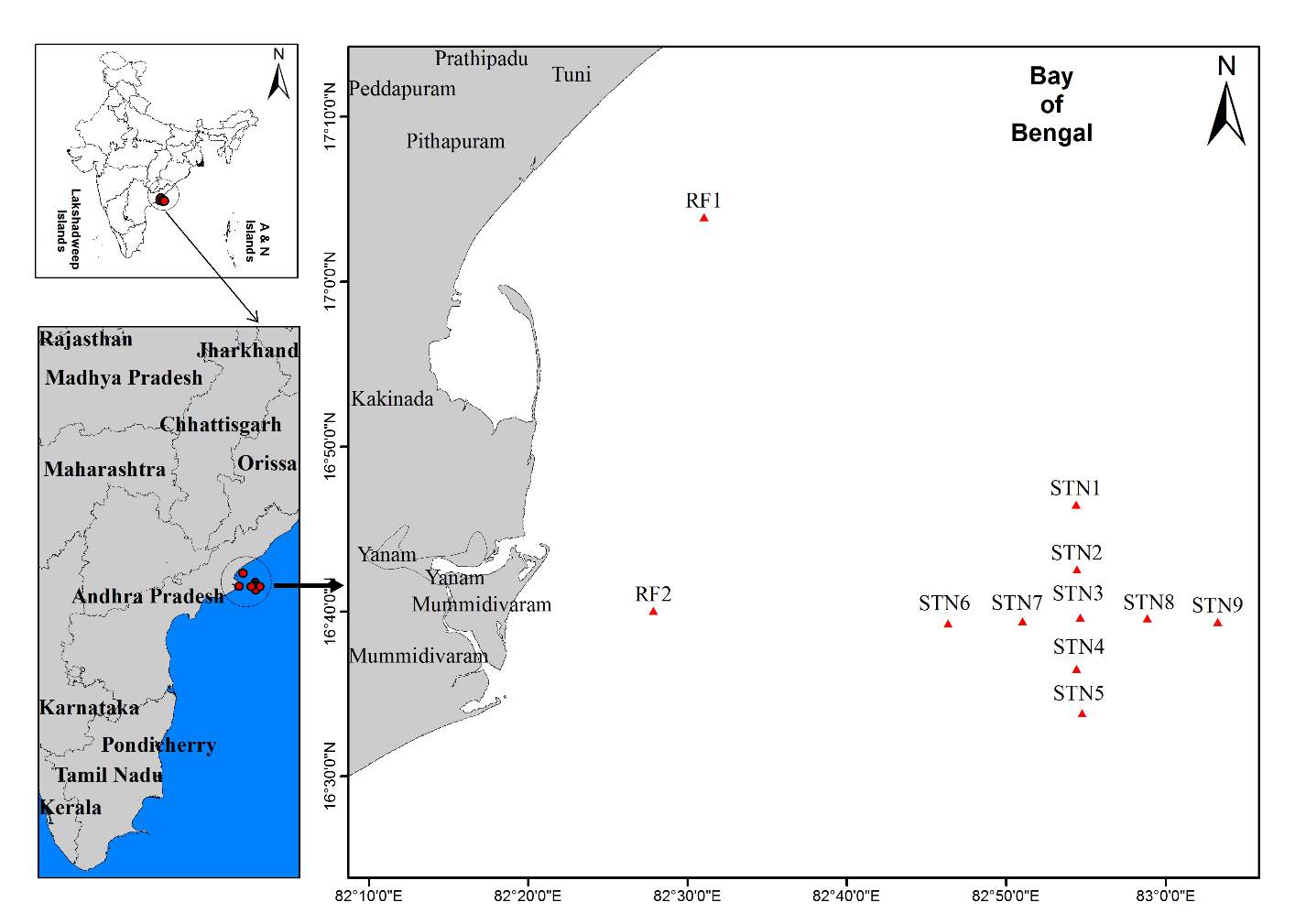
Fig . 2. Rainfall data from the study area.
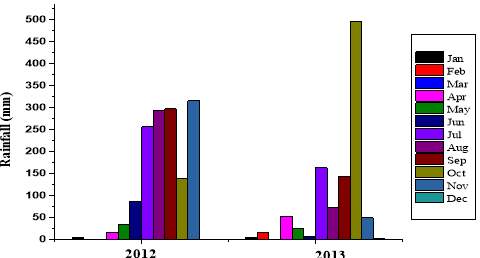
Fig . 3. Box plots of seasonal variations for selected parameters
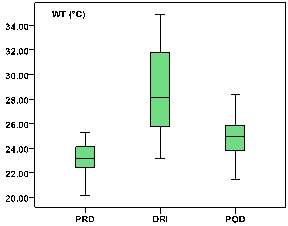
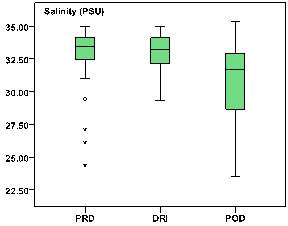
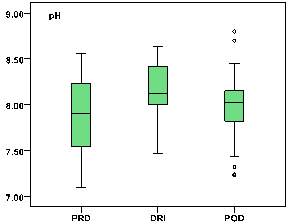

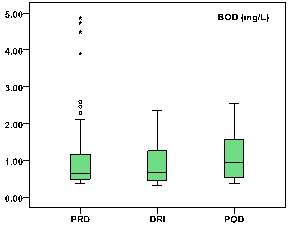
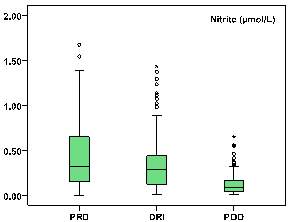
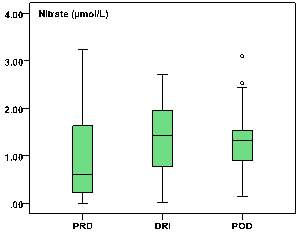
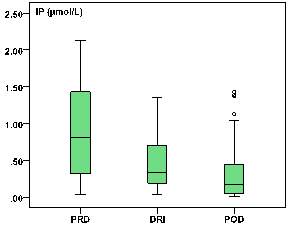
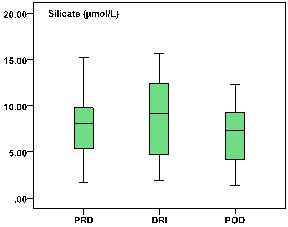

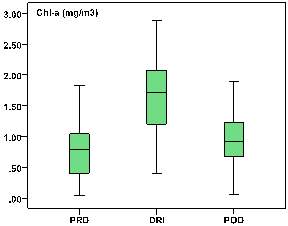
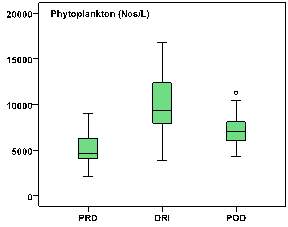
Fig. 3. Box plots of seasonal variations for selected parameters (DO: Dissolved Oxygen, PHC: Petroleum Hydro Carbon, IP: Inorganic Phosphate). In each box plot, the central point represents the median; the whisker indicates the range. The outliers values are given as dots.
Cite This Work
To export a reference to this article please select a referencing stye below:
Related Services
View allRelated Content
All TagsContent relating to: "Environmental Science"
Environmental science is an interdisciplinary field focused on the study of the physical, chemical, and biological conditions of the environment and environmental effects on organisms, and solutions to environmental issues.
Related Articles
DMCA / Removal Request
If you are the original writer of this dissertation and no longer wish to have your work published on the UKDiss.com website then please:




